Notes
Editorial note
It has been brought to the authors' attention that there may be an error in the data (Analysis 1.9). This is currently under investigation, and a correction will be made if the data are found to be incorrect. Details can be found in the comments.
Abstract
Background
Women with a suspected large‐for‐dates fetus or a fetus with suspected macrosomia (birthweight greater than 4000 g) are at risk of operative birth or caesarean section. The baby is also at increased risk of shoulder dystocia and trauma, in particular fractures and brachial plexus injury. Induction of labour may reduce these risks by decreasing the birthweight, but may also lead to longer labours and an increased risk of caesarean section.
Objectives
To assess the effects of a policy of labour induction at or shortly before term (37 to 40 weeks) for suspected fetal macrosomia on the way of giving birth and maternal or perinatal morbidity.
Search methods
We searched the Cochrane Pregnancy and Childbirth Group's Trials Register (31 January 2016), contacted trial authors and searched reference lists of retrieved studies.
Selection criteria
Randomised trials of induction of labour for suspected fetal macrosomia.
Data collection and analysis
Review authors independently assessed trials for inclusion and risk of bias, extracted data and checked them for accuracy. We contacted study authors for additional information. For key outcomes the quality of the evidence was assessed using the GRADE approach.
Main results
We included four trials, involving 1190 women. It was not possible to blind women and staff to the intervention, but for other 'Risk of bias' domains these studies were assessed as being at low or unclear risk of bias.
Compared to expectant management, there was no clear effect of induction of labour for suspected macrosomia on the risk of caesarean section (risk ratio (RR) 0.91, 95% confidence interval (CI) 0.76 to 1.09; 1190 women; four trials, moderate‐quality evidence) or instrumental delivery (RR 0.86, 95% CI 0.65 to 1.13; 1190 women; four trials, low‐quality evidence). Shoulder dystocia (RR 0.60, 95% CI 0.37 to 0.98; 1190 women; four trials, moderate‐quality evidence), and fracture (any) (RR 0.20, 95% CI 0.05 to 0.79; 1190 women; four studies, high‐quality evidence) were reduced in the induction of labour group. There were no clear differences between groups for brachial plexus injury (two events were reported in the control group in one trial, low‐quality evidence). There was no strong evidence of any difference between groups for measures of neonatal asphyxia; low five‐minute infant Apgar scores (less than seven) or low arterial cord blood pH (RR 1.51, 95% CI 0.25 to 9.02; 858 infants; two trials, low‐quality evidence; and, RR 1.01, 95% CI 0.46 to 2.22; 818 infants; one trial, moderate‐quality evidence, respectively).
Mean birthweight was lower in the induction group, but there was considerable heterogeneity between studies for this outcome (mean difference (MD) ‐178.03 g, 95% CI ‐315.26 to ‐40.81; 1190 infants; four studies; I2 = 89%). In one study with data for 818 women, third‐ and fourth‐degree perineal tears were increased in the induction group (RR 3.70, 95% CI 1.04 to 13.17).
For outcomes assessed using GRADE, we based our downgrading decisions on high risk of bias from lack of blinding and imprecision of effect estimates.
Authors' conclusions
Induction of labour for suspected fetal macrosomia has not been shown to alter the risk of brachial plexus injury, but the power of the included studies to show a difference for such a rare event is limited. Also antenatal estimates of fetal weight are often inaccurate so many women may be worried unnecessarily, and many inductions may not be needed. Nevertheless, induction of labour for suspected fetal macrosomia results in a lower mean birthweight, and fewer birth fractures and shoulder dystocia. The unexpected observation in the induction group of increased perineal damage, and the plausible, but of uncertain significance, observation of increased use of phototherapy, both in the largest trial, should also be kept in mind.
Findings from trials included in the review suggest that to prevent one fracture it would be necessary to induce labour in 60 women. Since induction of labour does not appear to alter the rate of caesarean delivery or instrumental delivery, it is likely to be popular with many women. In settings where obstetricians can be reasonably confident about their scan assessment of fetal weight, the advantages and disadvantages of induction at or near term for fetuses suspected of being macrosomic should be discussed with parents.
Although some parents and doctors may feel the evidence already justifies induction, others may justifiably disagree. Further trials of induction shortly before term for suspected fetal macrosomia are needed. Such trials should concentrate on refining the optimum gestation of induction, and improving the accuracy of the diagnosis of macrosomia.
Plain language summary
Induction of labour at or near the end of pregnancy for babies suspected of being very large (macrosomia)
What is the issue?
Babies who are very large (or macrosomic, weighing over 4000 g when born) can have difficult and occasionally traumatic births. One suggestion to try to reduce this trauma has been to induce labour early, before the baby grows too big. The estimation of the baby's weight is difficult before birth and not very accurate. Clinical estimations are based on feeling the uterus and measuring the height of the fundus of the uterus. Both are subject to considerable variation. Ultrasound scanning is also not accurate, so suspected large babies may not be confirmed at delivery. This may worry parents.
Why is this important?
If undertaken too early, induction of labour can lead to babies being born prematurely and with immature organs.
What evidence did we find?
We found four trials that assessed induction of labour at 37 to 40 weeks for women when it was suspected that their baby was large. A total of 1190 pregnant, non‐diabetic women were involved. We searched for evidence on 31 October 2015. The studies were of moderate or good quality although it was not possible to blind the women and staff providing care to which group women had been assigned. This may have introduced bias.
What does this mean?
The number of births where the baby's shoulder became stuck (shoulder dystocia) or a bone was fractured (usually the clavicle, which heals well without consequences) were reduced in the induction of labour group. The evidence was assessed as moderate quality for shoulder dystocia and high quality for fracture. No clear differences between groups were reported for damage to the network of nerves that send signals from the spine to the shoulder, arm and hand (brachial plexus injury) of the baby (low‐quality evidence due to very few events occurring) or signs of not enough oxygen during birth. A policy of labour induction reduced the average birthweight of babies by 178 g. The trials did not show any differences in the number of women who had caesarean sections or instrumental births. There is limited evidence that more women in the induction of labour group had severe damage to the perineum. We conclude that there appear to be benefits, but there may also be some disadvantages of induction of labour shortly before term. The option of having an induction should be discussed with parents when their baby is suspected to be extra large.
Although some parents and doctors may feel the existing evidence is sufficient to justify inducing labour, others may disagree. Further high‐quality studies are needed in order to find out what is the best time to induce labour towards the end of pregnancy, and how to improve the accuracy in diagnosing macrosomia.
A visual summary of some of the results from this review can be found here (screen view version) and (printable version here).
Summary of findings
Summary of findings 1. Induction of labour versus expectant management for suspected fetal macrosomia.
| Induction of labour versus expectant management for suspected fetal macrosomia | |||||
| Patient or population: women with term or near term (> 37 weeks' gestation) with suspected fetal macrosomia Setting: data from four trials: a multi‐centre study in France, Belgium and Switzerland and studies in UK, Israel and USA Intervention: induction of labour Comparison: expectant management | |||||
| Outcomes | Anticipated absolute effects* (95% CI) | Relative effect (95% CI) | № of participants (studies) | Quality of the evidence (GRADE) | |
| Risk with expectant management | Risk with Induction | ||||
| Caesarean section | Study population | RR 0.91 (0.76 to 1.09) | 1190 (4 RCTs) | ⊕⊕⊕⊝ MODERATE 1 | |
| 293 per 1000 | 267 per 1000 (223 to 320) | ||||
| Moderate | |||||
| 296 per 1000 | 269 per 1000 (225 to 323) | ||||
| Instrumental delivery | Study population | RR 0.86 (0.65 to 1.13) | 1190 (4 RCTs) | ⊕⊕⊝⊝ LOW 1 2 | |
| 152 per 1000 | 130 per 1000 (99 to 171) | ||||
| Moderate | |||||
| 148 per 1000 | 127 per 1000 (96 to 167) | ||||
| Shoulder dystocia | Study population | RR 0.60 (0.37 to 0.98) | 1190 (4 RCTs) | ⊕⊕⊕⊝ MODERATE 1 3 | |
| 68 per 1000 | 41 per 1000 (25 to 67) | ||||
| Moderate | |||||
| 61 per 1000 | 36 per 1000 (22 to 59) | ||||
| Brachial plexus injury | Study population | RR 0.21 (0.01 to 4.28) | 1190 (4 RCTs) | ⊕⊕⊝⊝ LOW 4 | |
| 3 per 1000 | 1 per 1000 (0 to 14) | ||||
| Fracture (any) | Study population | RR 0.20 (0.05 to 0.79) | 1190 (4 RCTs) | ⊕⊕⊕⊕ HIGH 5 | |
| 20 per 1000 | 4 per 1000 (1 to 16) | ||||
| Moderate | |||||
| 10 per 1000 | 2 per 1000 (0 to 8) | ||||
| Low Apgar score (5 minutes) | Study population | RR 1.51 (0.25 to 9.02) | 858 (2 RCTs) | ⊕⊕⊝⊝ LOW 4 | |
| 5 per 1000 | 7 per 1000 (1 to 42) | ||||
| Moderate | |||||
| 2 per 1000 | 4 per 1000 (1 to 22) | ||||
| Low arterial cord blood pH (< 7.10) | Study population | RR 1.01 (0.46 to 2.22) | 818 (1 RCT) | ⊕⊕⊕⊝ MODERATE 2 | |
| 29 per 1000 | 29 per 1000 (13 to 65) | ||||
| Moderate | |||||
| 29 per 1000 | 29 per 1000 (13 to 65) | ||||
| *The risk in the intervention group (and its 95% confidence interval) is based on the assumed risk in the comparison group and the relative effect of the intervention (and its 95% CI). CI: Confidence interval; RR: Risk ratio; OR: Odds ratio; | |||||
| GRADE Working Group grades of evidence High quality: We are very confident that the true effect lies close to that of the estimate of the effect Moderate quality: We are moderately confident in the effect estimate: The true effect is likely to be close to the estimate of the effect, but there is a possibility that it is substantially different Low quality: Our confidence in the effect estimate is limited: The true effect may be substantially different from the estimate of the effect Very low quality: We have very little confidence in the effect estimate: The true effect is likely to be substantially different from the estimate of effect | |||||
1 Studies contributing data were at risk of bias (lack of blinding)
2 Wide 95% CI crossing the line of no effect
3 We downgraded this outcome for lack of blinding (clinical assessment of dystocia could be affected by lack of blinding)
4 Wide 95% CI crossing the line of no effect and low event rate
5 Not downgraded for low event rates due to fairly large sample, and 95% CI not crossing the line of no effect, and we considered this outcome was less likely to be affected by lack of blinding
Background
Description of the condition
Macrosomia is usually defined as a birthweight above 4000 g, although sometimes a higher cut‐off is used (4500 g) (Delpapa 1991; Chatfield 2001: Ju 2009). Large‐for‐gestational‐age fetuses are usually defined as those with a birthweight above the 90th percentile. Approximately 10% of pregnancies are affected by macrosomia, although estimates range from 3% to 15% in different settings (Chatfield 2001; Mohammadbeigi 2013).
Risk factors for giving birth to a large birthweight infant include a previous history of macrosomia, maternal obesity, maternal weight gain during pregnancy, multiparity and male fetus (Berard 1998; Cameron 2014; Gaudet 2014).
Macrosomia is associated with a prolonged labour and maternal trauma along with a higher risk of birth injuries for the infant and longer‐term adverse consequences (Ju 2009; Chatfield 2001; Mohammadbeigi 2013; Perlow 1996). Women with large‐for‐dates fetuses are more likely to have labour augmentation and caesarean section, more serious perineal trauma, and more severe morbidity. High birthweight babies are at higher risk of sustaining injuries at the birth; risks of shoulder dystocia, fracture and brachial plexus injury are increased. There is an increased risk of fetal death and neonatal complications, and the risks of diabetes and cardiovascular disease in childhood and adult life are also elevated.
Description of the intervention
Before caesarean section became reasonably safe, induction of labour for suspected macrosomia was performed because it was thought to prevent severe cephalo‐pelvic disproportion and its associated maternal mortality and severe morbidity (Thiery 1989).
Nowadays, some obstetricians induce labour at term when the fetus is estimated to be either large‐for‐gestational age or macrosomic.
How the intervention might work
The purpose of labour induction at or shortly before term (37 to 40 weeks) in case of suspected fetal macrosomia is to reduce the likelihood of a difficult birth, possibly resulting in maternal or perinatal morbidity (Perlow 1996). In particular, the risk of shoulder dystocia and the associated risk of neonatal trauma might be reduced by the intervention. Observational studies cast doubts on the effectiveness of such a policy (Friesen 1995; Weeks 1995), and have suggested that induction increases the risk of caesarean section without reducing birth injury.
Weighing the infant after the birth is the only accurate way to identify macrosomia. For a policy of induction to be effective, large‐for‐gestational‐age fetuses must be reliably identified before they become macrosomic. Estimation of the fetal weight is difficult. Clinical estimation based on manual palpation of the uterus or uterine height measurements, as well as ultrasound scanning, is a method currently used to attempt to predict the fetal weight. The predictive value of such tests, especially for large fetuses, is poor (Coomarasamy 2005; Johnstone 1997). Magnetic Resonance Imaging (MRI) may be a more accurate method for estimating fetal weight, but at present the evidence for this is limited (Malin 2016). The accuracy of fetal weight estimation may be one of the limitations of a policy of induction of labour for suspected macrosomia.
Why it is important to do this review
In cases of suspected fetal macrosomia, it has not been clear whether a policy of induction of labour affects the risk of having caesarean section, instrumental birth, or perineal trauma, or improves outcomes for babies. The purpose of the review is to compare outcomes in women and infants where induction of labour has been compared with expectant management in randomised controlled trials. The review will be useful to guide clinical decisions and to allow women to make more informed choices about their care in cases of suspected large‐for‐dates fetus.
Objectives
To evaluate a policy of labour induction for suspected fetal macrosomia on the risk of caesarean section, instrumental delivery and perineal trauma.
To evaluate a policy of labour induction for suspected fetal macrosomia on the risk of shoulder dystocia, birth trauma or asphyxia, and infant morbidity.
Methods
Criteria for considering studies for this review
Types of studies
We included all known randomised controlled trials evaluating labour induction for suspected fetal macrosomia. We planned to include cluster‐randomised trials if any were identified. We planned to exclude quasi‐randomised trials and studies using a cross‐over design; the latter type of study is not an appropriate design for this type of intervention.
Types of participants
Term (37 to 40 weeks' gestation) pregnant women bearing a fetus suspected to be macrosomic and without other indications for induction of labour.
Types of interventions
We considered studies comparing induction of labour with expectant management for inclusion in this review.
Types of outcome measures
Primary outcomes
Maternal outcomes
Caesarean section
Instrumental delivery
Perinatal outcomes
Shoulder dystocia
Brachial plexus injury
Fracture (any)
Neonatal asphyxia (low arterial cord blood pH, or low five‐minute Apgar score
Secondary outcomes
Maternal outcomes
Spontaneous delivery
Third‐ and fourth‐degree perineal tears
Maternal dissatisfaction (pain, sexual dysfunction)
Perinatal outcomes
Mean birthweight (g)
Admission to neonatal intensive care unit
Intracranial haemorrhage
Convulsions
Perinatal mortality
Long‐term disability in childhood
In this version of the review we have also reported findings for the following non pre‐specified outcomes.
Significant shoulder dystocia (trialist defined)
Serious neonatal morbidity or death (composite outcome)
Use of phototherapy
Cephalohematoma
Search methods for identification of studies
The following methods section of this review is based on a standard template used by the Cochrane Pregnancy and Childbirth Group.
Electronic searches
We searched the Cochrane Pregnancy and Childbirth Group’s Trials Register by contacting the Trials Search Co‐ordinator (31 January 2016).
The Register is a database containing over 20,000 reports of controlled trials in the field of pregnancy and childbirth. For full search methods used to populate the Pregnancy and Childbirth Group’s Trials Register including the detailed search strategies for CENTRAL, MEDLINE, Embase and CINAHL; the list of handsearched journals and conference proceedings, and the list of journals reviewed via the current awareness service, please follow this link to the editorial information about the Cochrane Pregnancy and Childbirth Group in The Cochrane Library and select the ‘Specialized Register ’ section from the options on the left side of the screen.
Briefly, the Cochrane Pregnancy and Childbirth Group’s Trials Register is maintained by the Trials Search Co‐ordinator and contains trials identified from:
monthly searches of the Cochrane Central Register of Controlled Trials (CENTRAL);
weekly searches of MEDLINE (Ovid);
weekly searches of Embase (Ovid);
monthly searches of CINAHL (EBSCO);
handsearches of 30 journals and the proceedings of major conferences;
weekly current awareness alerts for a further 44 journals plus monthly BioMed Central email alerts.
Search results are screened by two people and the full text of all relevant trial reports identified through the searching activities described above is reviewed. Based on the intervention described, each trial report is assigned a number that corresponds to a specific Pregnancy and Childbirth Group review topic (or topics), and is then added to the Register. The Trials Search Co‐ordinator searches the Register for each review using this topic number rather than keywords. This results in a more specific search set which has been fully accounted for in the relevant review sections (Included and Ongoing studies).
Searching other resources
We searched the reference lists of retrieved studies and contacted trial authors for unpublished data.
We did not apply any language or date restrictions.
Data collection and analysis
For methods used in the previous version of this review, seeIrion 1998.
For this update, we used the following methods, which are based on a standard template used by the Cochrane Pregnancy and Childbirth Group.
Selection of studies
Two review authors independently assessed for inclusion all the potential studies identified as a result of the search strategy. We resolved any disagreement through discussion.
Data extraction and management
We designed a form to extract data. For eligible studies, two review authors extracted the data using the agreed form. We resolved discrepancies through discussion. Data were entered into Review Manager software (RevMan 2014) and checked for accuracy. Three of the review authors (MB, OI and JT) were investigators on trials included in the review; these authors were not involved in data extraction or assessing risk of bias for their trials.
When information regarding any of the above was unclear, we planned to contact authors of the original reports to provide further details.
Assessment of risk of bias in included studies
Two review authors independently assessed risk of bias for each study using the criteria outlined in the Cochrane Handbook for Systematic Reviews of Interventions (Higgins 2011). Any disagreement was resolved by discussion or by involving a third assessor.
(1) Random sequence generation (checking for possible selection bias)
We described for each included study the method used to generate the allocation sequence in sufficient detail to allow an assessment of whether it should produce comparable groups.
We assessed the method as:
low risk of bias (any truly random process, e.g. random number table; computer random number generator);
high risk of bias (any non‐random process, e.g. odd or even date of birth; hospital or clinic record number);
unclear risk of bias.
(2) Allocation concealment (checking for possible selection bias)
We described for each included study the method used to conceal allocation to interventions prior to assignment and assessed whether intervention allocation could have been foreseen in advance of, or during recruitment, or changed after assignment.
We assessed the methods as:
low risk of bias (e.g. web or telephone randomisation; consecutively numbered sealed opaque envelopes);
high risk of bias (open list of random allocation; unsealed or non‐opaque envelopes, alternation; date of birth);
unclear risk of bias.
(3.1) Blinding of participants and personnel (checking for possible performance bias)
Blinding of staff or women to this type of intervention is not feasible. However, for each outcome we were able to consider whether lack of blinding was likely to affect results.
(3.2) Blinding of outcome assessment (checking for possible detection bias)
We described for each included study the methods used, if any, to blind outcome assessors from knowledge of which intervention a participant received. We assessed blinding separately for different outcomes or classes of outcomes.
We assessed methods used to blind outcome assessment as:
low, high or unclear risk of bias.
(4) Incomplete outcome data (checking for possible attrition bias due to the amount, nature and handling of incomplete outcome data)
We described for each included study, and for each outcome or class of outcomes, the completeness of data including attrition and exclusions from the analysis. We stated whether attrition and exclusions were reported and the numbers included in the analysis at each stage (compared with the total randomised participants), reasons for attrition or exclusion where reported, and whether missing data were balanced across groups or were related to outcomes. Where sufficient information was reported, or could be supplied by the trial authors, we planned to re‐include missing data in the analyses which we undertook.
We assessed methods as:
low risk of bias (e.g. no missing outcome data; missing outcome data balanced across groups);
high risk of bias (e.g. numbers or reasons for missing data imbalanced across groups; ‘as treated’ analysis done with substantial departure of intervention received from that assigned at randomisation);
unclear risk of bias.
(5) Selective reporting (checking for reporting bias)
We described for each included study how we investigated the possibility of selective outcome reporting bias and what we found.
We assessed the methods as:
low risk of bias (where it is clear that all of the study’s pre‐specified outcomes and all expected outcomes of interest to the review have been reported);
high risk of bias (where not all the study’s pre‐specified outcomes have been reported; one or more reported primary outcomes were not pre‐specified; outcomes of interest are reported incompletely and so cannot be used; study fails to include results of a key outcome that would have been expected to have been reported);
unclear risk of bias.
(6) Other bias (checking for bias due to problems not covered by (1) to (5) above)
We described for each included study any important concerns we had about other possible sources of bias.
(7) Overall risk of bias
We made explicit judgements about whether studies were at high risk of bias, according to the criteria given in the Handbook (Higgins 2011). With reference to (1) to (6) above, we planned to assess the likely magnitude and direction of the bias and whether we considered it is likely to impact on the findings. In future updates, if more data become available, we will explore the impact of the level of bias through undertaking sensitivity analyses ‐ see Sensitivity analysis.
Measures of treatment effect
Dichotomous data
For dichotomous data, we presented results as summary risk ratio with 95% confidence intervals.
Continuous data
We used the mean difference if outcomes were measured in the same way between trials. We planned to use the standardised mean difference to combine trials that measured the same outcome, but used different methods.
Unit of analysis issues
Cluster‐randomised trials
No cluster‐randomised trials were identified by the search strategy. In future versions of the review, if such trials are identified, we will include cluster‐randomised trials in the analyses along with individually‐randomised trials. We will adjust their sample sizes using the methods described in the Handbook using an estimate of the intracluster correlation co‐efficient (ICC) derived from the trial (if possible), from a similar trial or from a study of a similar population. If we use ICCs from other sources, we will report this and conduct sensitivity analyses to investigate the effect of variation in the ICC. If we identify both cluster‐randomised trials and individually‐randomised trials, we plan to synthesise the relevant information. We will consider it reasonable to combine the results from both if there is little heterogeneity between the study designs and the interaction between the effect of intervention and the choice of randomisation unit is considered to be unlikely.
We will also acknowledge heterogeneity in the randomisation unit and perform a sensitivity analysis to investigate the effects of the randomisation unit.
Dealing with missing data
For included studies, levels of attrition were noted. In future updates, if more eligible studies are included, the impact of including studies with high levels of missing data in the overall assessment of treatment effect will be explored by using sensitivity analysis.
For all outcomes, analyses were carried out, as far as possible, on an intention‐to‐treat basis, i.e. we attempted to include all participants randomised to each group in the analyses. The denominator for each outcome in each trial was the number randomised minus any participants whose outcomes were known to be missing.
Assessment of heterogeneity
We assessed statistical heterogeneity in each meta‐analysis using the Tau², I² and Chi² statistics. We regarded heterogeneity as substantial if an I² was greater than 30% and either a Tau² was greater than zero, or there was a low P value (less than 0.10) in the Chi² test for heterogeneity. Had we identified substantial heterogeneity (above 30%), we planned to explore it by pre‐specified subgroup analysis; we did not carry out this further analysis in this version of the review due to insufficient data.
Assessment of reporting biases
In future updates, if there are 10 or more studies in the meta‐analysis, we will investigate reporting biases (such as publication bias) using funnel plots. We will assess funnel plot asymmetry visually. If asymmetry is suggested by a visual assessment, we will perform exploratory analyses to investigate it.
Data synthesis
We carried out statistical analysis using the Review Manager software (RevMan 2014). We used fixed‐effect meta‐analysis for combining data where it was reasonable to assume that studies were estimating the same underlying treatment effect: i.e. where trials were examining the same intervention, and the trials’ populations and methods were judged sufficiently similar.
If there was clinical heterogeneity sufficient to expect that the underlying treatment effects differed between trials, or if substantial statistical heterogeneity was detected, we used random‐effects meta‐analysis to produce an overall summary, if an average treatment effect across trials was considered clinically meaningful. The random‐effects summary represents the average range of possible treatment effects and we discussed the clinical implications of treatment effects differing between trials. If the average treatment effect was not clinically meaningful, we did not combine trials. For results where we have used random‐effects analyses, the results have been presented as the average treatment effect with 95% confidence intervals, and the estimates of Tau² and I².
Subgroup analysis and investigation of heterogeneity
Had we identified substantial heterogeneity, we planned to investigate it using subgroup analyses.
We planned the following subgroup analyses.
Clinical estimation based on palpation of the uterus versus ultrasound scanning.
Maternal diabetes versus no maternal diabetes.
Previous macrosomic infant versus no previous macrosomic infant.
We planned to use the primary outcomes in subgroup analysis.
In this version of the review too few studies were included to allow meaningful subgroup analyses. If sufficient data are available for future updates we will assess subgroup differences by interaction tests available within RevMan (RevMan 2014). We will report the results of subgroup analyses quoting the Chi² statistic and P value, and the interaction test I² value.
Sensitivity analysis
We planned to carry out sensitivity analyses to explore the effect of trial quality assessed by concealment of allocation, high attrition rates, or both, with poor‐quality studies being excluded from the analyses in order to assess whether this makes any difference to the overall result. In this version of the review there were insufficient data to allow for these planned analyses.
Summary of findings and assessment of the certainty of the evidence
For this update the quality of the evidence has been evaluated using the GRADE approach as outlined in the GRADE Handbook in order to assess the quality of the body of evidence relating to the following outcomes.
Maternal outcomes
Caesarean section
Instrumental delivery
Perinatal outcomes
Shoulder dystocia
Brachial plexus injury
Fracture (any)
Neonatal asphyxia (low arterial cord blood pH, or low five‐minute Apgar score)
We used the GRADEpro Guideline Development Tool to import data from Review Manager 5.3 (RevMan 2014) in order to create a ’Summary of findings’ table. A summary of the intervention effect and a measure of quality for each of the above outcomes was produced using the GRADE approach. The GRADE approach uses five considerations (study limitations, consistency of effect, imprecision, indirectness and publication bias) to assess the quality of the body of evidence for each outcome. The evidence can be downgraded from 'high quality' by one level for serious (or by two levels for very serious) limitations, depending on assessments for risk of bias, indirectness of evidence, serious inconsistency, imprecision of effect estimates or potential publication bias.
Results
Description of studies
Results of the search
We identified 10 reports of five trials. Four trials (nine reports) involving 1190 women, are included and one trial (Perlitz 2014) is in the Ongoing studies section.
Included studies
Study design and settings
We included four randomised controlled trials (Boulvain 2015; Gonen 1997; LIBBY 1998; Tey 1995).
The trial contributing most data to the review (Boulvain 2015), was a multi‐centre RCT carried out in 19 hospitals in France, Switzerland and Belguim. Recruitment was between 2002 to 2009 and 822 women were randomised. The other three studies included in the review were carried out in Israel, USA and UK during the1990s had smaller sample sizes. In the study by Gonen 1997, 273 women with a gestational age of 38 completed weeks or more were recruited. The LIBBY 1998 and Tey 1995 studies recruited women after 37 weeks (with 59 and 40 women randomised respectively).
Participants
In two trials women were included when fetal weight, estimated by ultrasound examination, was between 4000 g and 4500 g (Gonen 1997), or between 4000 g and 4750 g (Tey 1995). The third trial (LIBBY 1998) included women whose fetus was estimated to weigh more than the 97th percentile at the time of inclusion. The fourth trial (Boulvain 2015), included women whose fetus was estimated by sonograph to weigh more than the 95th centile. When estimated fetal weight was greater than 4500 g in the Gonen 1997 trial, elective caesarean section was performed. Women with diabetes were excluded from two of these trials (Gonen 1997; Tey 1995). In the Boulvain 2015 trial, women with diabetes treated with insulin were excluded, although 10% of included participants had gestational diabetes mellitus (GDM) controlled by diet. Limited information is available for the LIBBY 1998 pilot study.
Interventions and comparisons
In the largest trial (Boulvain 2015), labour was induced between 37+0 and 38+6 weeks and within three days or randomisation. The method of induction was at the discretion of the attending physician and according to local protocol. Women with unfavourable cervix had cervical ripening with misoprostol or prostaglandin E2 (PGE2) followed by oxytocin infusion if labour had not started.
In the other trials, the method used for labour induction also depended on cervical status (prostaglandins for cervical ripening in the case of an unfavourable cervix, otherwise oxytocin infusion). Women in the expectant management group underwent induction of labour upon completion of 42 weeks of gestation in the Gonen 1997 trial.
We obtained additional (unpublished) information for the four included studies. All the results of the Libby pilot study are unpublished (LIBBY 1998).
Excluded studies
There are no excluded studies.
Risk of bias in included studies
See Figure 1 and Figure 2 for a summary of 'Risk of bias' assessments in studies.
1.
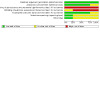
'Risk of bias' graph: review authors' judgements about each risk of bias item presented as percentages across all included studies.
2.
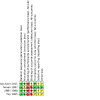
'Risk of bias' summary: review authors' judgements about each risk of bias item for each included study.
Allocation
Generation of the randomisation sequence
All studies used a computer‐generated table of random numbers or Internet‐based randomisation (low risk of bias).
Allocation concealment
In two of the studies, sealed, sequentially numbered, opaque envelopes were used (LIBBY 1998; Tey 1995) and the Boulvain 2015 trial used a central randomisation service (all three studies assessed as low risk of bias). In the other report, the method for concealment of the random allocation was not described (Gonen 1997) (unclear risk of bias).
Blinding
Although blinding of women and staff was not reported in three studies (Gonen 1997; LIBBY 1998; Tey 1995) we have assumed that it had not been attempted. It was reported to be not possible in one study (Boulvain 2015); all four studies were assessed as high risk of bias for performance bias. There was no mention of any attempt to blind outcome assessors in three studies (Gonen 1997; LIBBY 1998; Tey 1995), and again, we assumed that it had not been attempted and assessed these studies as high risk of bias for detection bias. In one study it was stated that the assessment of the primary outcome was by investigators masked to group allocation (Boulvain 2015); we assessed this study as unclear risk of bias for this domain as most outcomes would be recorded in case notes by staff aware of the intervention group.
Incomplete outcome data
In one study (Gonen 1997), a few women (six in the induction group and five in the expectant group) were excluded from the study after randomisation, either because of withdrawal of consent or because they were lost to follow‐up. Apart from the fact that these women were excluded, an intention‐to‐treat analysis was performed (low risk of bias). In the LIBBY pilot (LIBBY 1998), 29/30 women in the induction group had induction, compared to 14/29 in the expectant management group; analysis was however performed on an intention‐to‐treat basis (low risk of bias). In the Boulvain 2015 study there was very little attrition bias (822 women randomised; 818 included in the analysis, two women in each group were lost to follow‐up) (low risk of bias). In the fourth study (Tey 1995), there was limited information in the abstract report (unclear risk of bias).
Selective reporting
All expected outcome results were reported in one study (Gonen 1997) (low risk of bias). In the Boulvain 2015 trial, we had access to the trial protocol and most outcomes reported in the main trial report were pre‐specified, there were some changes during the study as more centres were recruited (unclear risk of bias). It was not possible to tell if selective outcome reporting was apparent in the two remaining studies (LIBBY 1998; Tey 1995) (unclear risk of bias).
Other potential sources of bias
Baseline characteristics were similar between groups and no other bias was apparent in one study (Gonen 1997) (low risk of bias). It was not possible to tell if other sources of bias were apparent in the remaining three studies (Boulvain 2015; LIBBY 1998; Tey 1995) (unclear risk of bias).
Effects of interventions
See: Table 1
Induction of labour versus expectant management for suspected fetal macrosomia (four studies, 1190 women)
Primary outcomes
We identified four trials (Boulvain 2015; Gonen 1997; LIBBY 1998; Tey 1995), involving a total of 1190 women.
Maternal outcomes
Compared to expectant management, induction of labour for suspected macrosomia has not been shown to reduce the risk of caesarean section (risk ratio (RR) 0.91, 95% confidence interval (CI) 0.76 to 1.09; 1190 women; four studies, moderate‐quality evidence) Analysis 1.1, orinstrumental delivery (RR 0.86, 95% CI 0.65 to 1.13; 1190 women; four studies, low‐quality evidence), Analysis 1.2.
1.1. Analysis.
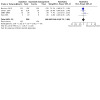
Comparison 1: Induction versus expectant management, Outcome 1: Caesarean section
1.2. Analysis.
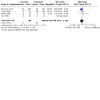
Comparison 1: Induction versus expectant management, Outcome 2: Instrumental delivery
Perinatal outcomes
The risks of shoulder dystocia and fracture (any) were lower in the induction group (RR 0.60, 95% CI 0.37 to 0.98; 1190 women; four trials, moderate‐quality evidence; and RR 0.20, 95% CI 0.05 to 0.79; 1190 women; four studies, high‐quality evidence, respectively) Analysis 1.3; Analysis 1.5. However, there were no clear differences between groups for brachial plexus injury, although this outcome was infrequent with one trial reporting two cases of brachial plexus injury in the expectant management group (Gonen 1997) (RR 0.21, 95% CI 0.01 to 4.28; four studies, 1190 women, low‐quality evidence) (Analysis 1.4). There was no strong evidence of any difference between groups for measures of neonatal asphyxia: low infant Apgar scores (less than seven) or low arterial cord blood pH (RR 1.51, 95% CI 0.25 to 9.02; 858 infants; two trials, low‐quality evidence; and, RR 1.01, 95% CI 0.46 to 2.22; 818 infants; one trial, moderate‐quality evidence, respectively), Analysis 1.6; Analysis 1.7.
1.3. Analysis.
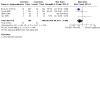
Comparison 1: Induction versus expectant management, Outcome 3: Shoulder dystocia
1.5. Analysis.

Comparison 1: Induction versus expectant management, Outcome 5: Fracture (any)
1.4. Analysis.
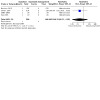
Comparison 1: Induction versus expectant management, Outcome 4: Brachial plexus injury
1.6. Analysis.
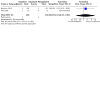
Comparison 1: Induction versus expectant management, Outcome 6: Low Apgar score (5 minutes)
1.7. Analysis.
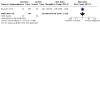
Comparison 1: Induction versus expectant management, Outcome 7: Low arterial cord blood pH (< 7.10)
Secondary outcomes
Maternal outcomes
All four studies reported spontaneous delivery and there was no clear evidence of differences between groups (RR 1.09, 95% CI 0.99 to 1.20; 1190 women) (Analysis 1.8). Two studies reported third‐ and fourth‐degree perineal tears, but only one had estimable data (Boulvain 2015); in this study the number of women with tears was increased in the induction of labour group, although the 95% CI was wide for this outcome (RR 3.70, 95% CI 1.04 to 13.17; 858 women), Analysis 1.9.
1.8. Analysis.
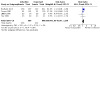
Comparison 1: Induction versus expectant management, Outcome 8: Spontaneous delivery
1.9. Analysis.
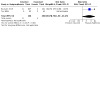
Comparison 1: Induction versus expectant management, Outcome 9: Third‐ and fourth‐degree perineal tears
No information is available about maternal dissatisfaction (pain, sexual dysfunction).
Infant outcomes
Three of the studies reported perinatal mortality, but there were no events reported in either group.
When cranial sonography was performed, a similar proportion of newborns with intraventricular haemorrhage was observed between the intervention and the control groups (RR 1.06, 95% CI 0.19 to 5.96; 933 infants; three studies), Analysis 1.11. One study reported on the outcome infant convulsions but there were no events in either group Analysis 1.12. There were no clear differences between groups for admission to neonatal intensive care in two studies reporting this outcome (RR 0.66, 95% CI 0.35 to 1.24; 858 infants; two studies) Analysis 1.13.
1.11. Analysis.
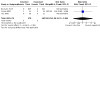
Comparison 1: Induction versus expectant management, Outcome 11: Intracranial haemorrhage
1.12. Analysis.
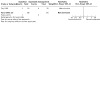
Comparison 1: Induction versus expectant management, Outcome 12: Convulsions
1.13. Analysis.
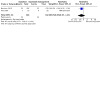
Comparison 1: Induction versus expectant management, Outcome 13: Admission to neonatal intensive care unit
In the pooled analysis, mean infant birthweight was lower in the induction group, although there were high levels of statistical heterogeneity for this outcome (mean difference (MD) ‐178.03 g, 95% CI ‐315.26 to ‐40.81; 1190 infants; four studies; I2 = 89%) Analysis 1.14.). For one study (LIBBY 1998), data for this outcome were reported as median and interquartile range; in order to use these data in the meta‐analysis, we entered the median as the measure of central tendency and estimated the standard deviations from the interquartile range. As we had estimated the standard deviations (and assumed that they were the same in both the intervention and control groups), we also carried out a sensitivity analysis using the standard deviations reported in the largest trial (Boulvain 2015); the sensitivity analysis showed similar results (MD ‐169.81, 95% CI ‐321.36 to ‐18.25) Analysis 1.15.
1.14. Analysis.
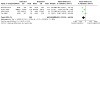
Comparison 1: Induction versus expectant management, Outcome 14: Mean birthweight (g)
1.15. Analysis.
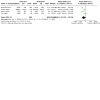
Comparison 1: Induction versus expectant management, Outcome 15: Sensitivity analysis: Mean birthweight (g)
It must be noted that in two of the trials (Gonen 1997; Tey 1995), despite induction of labour in the intervention group, groups were similar with regard to mean birthweight. The contrast between groups was larger in the LIBBY 1998 (‐295 g median difference between groups) and Boulvain 2015 trials (‐287 g difference).
There was no information on long‐term disability in childhood in any of the studies.
Non pre‐specified outcomes
The trial contributing most data (Boulvain 2015) reported outcomes that were not pre‐specified in the protocol for this review.
First, clinically significant shoulder dystocia, had been pre‐specified as a secondary outcome in the trial, and defined as "difficulty with delivery of the shoulders that was not resolved by the McRoberts' manoeuvre (flexion of the maternal thighs), usually combined with suprapubic pressure". It was reduced in the induction of labour group (RR 0.32, 95% CI 0.12 to 0.85; infants = 818; one study) (Analysis 1.16). The authors of the trial had also pre‐specified their primary fetal trial outcome as a composite of significant should dystocia and a range of birth injuries and death. That composite outcome was also reduced (RR 0·32 95% CI 0·15 to 0·71; infants = 818) (Analysis 1.17).
1.16. Analysis.
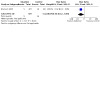
Comparison 1: Induction versus expectant management, Outcome 16: Non pre‐specified outcome: significant shoulder dystocia
1.17. Analysis.
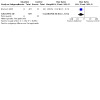
Comparison 1: Induction versus expectant management, Outcome 17: Non pre‐specified outcome: serious neonatal morbidity or death (composite outcome)
A further outcome reported by Boulvain 2015, was the use of neonatal phototherapy. Although this had been pre‐specified neither in the trial nor in this review, it was increased in the induction of labour group; induction 45 (11%) versus control 27 (7%), nominal P = 0·03 (RR 1.68, 95% CI 1.07 to 2.66; infants = 818) )(Analysis 1.18).
1.18. Analysis.
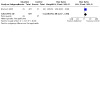
Comparison 1: Induction versus expectant management, Outcome 18: Non pre‐specified outcome: use of phototherapy
Finally, Gonen 1997 reported cephalohematoma, and there was no clear evidence that this outcome differed between groups (RR 2.07, 95% CI 0.53 to 8.13; infants = 273) (Analysis 1.19.
1.19. Analysis.

Comparison 1: Induction versus expectant management, Outcome 19: Non pre‐specified outcome: cephalohematoma
Insufficient data were available to allow us to perform planned subgroup analysis.
Discussion
Summary of main results
The review included four randomised controlled trials involving 1190 women, although one trial (Boulvain 2015) with 822 women contributed most of the data.
Induction of labour shortly before term for suspected fetal macrosomia in non‐diabetic women reduces both neonatal fractures and shoulder dystocia. The number needed to treat per fracture prevented is 60. Specifically, the evidence does not seem to suggest that a policy of induction increases the risk of caesarean section or instrumental birth, and may slightly reduce the former. Neonatal brachial plexus injury was reported for two babies in the control group, but the power of the included studies to show a difference between groups for such a rare event is limited. In one trial (Boulvain 2015), an increase in phototherapy in the induction group, was observed, but this was not pre‐specified in that trial nor in this review, and none of the infants involved had bilirubin levels over the normal cut‐off for phototherapy in the trial centres, namely 350 mmol/L, and the nominal statistical test result took no account of multiple testing. We are therefore uncertain of the clinical significance of this finding. All other neonatal outcomes were similar between groups. One trial (Boulvain 2015), also pre‐specified a composite primary fetal trial outcome of significant shoulder dystocia and other types of birth injury. Although not pre‐specified in our review protocol, it was significantly reduced in the induction group in that trial. Finally, there was an unanticipated increase in third‐ and fourth‐degree perineal tears in the induction group in the same trial.
Overall completeness and applicability of evidence
The meta‐analysis of the effect of induction on mean birthweight showed a high level of heterogeneity, which was explained by differences in trial design. Two studies (Gonen 1997; Tey 1995) included pregnancies around 40 weeks with an estimated fetal weight of more than 4000 g. As a result, despite induction of labour, the groups were similar with regard to gestational age at delivery and mean birthweight. The intervention was probably not performed early enough to avoid excessive birthweight. The two trials (Boulvain 2015; LIBBY 1998) that included women at an earlier gestational age observed a larger contrast in birthweight between groups.
Quality of the evidence
The overall quality of the evidence of the three smaller trials was at best moderate. However, the new trial (Boulvain 2015), apart from lack of blinding was assessed as being at low risk of bias and as this trial now dominates the review, we have judged that overall findings were at fairly low risk of bias. This is summarised in the 'Risk of bias' summary figures, Figure 1; Figure 2. We used GRADEpro software to grade evidence for our primary outcomes; for fracture the evidence was rated as high quality while for other primary outcomes, evidence was downgraded to moderate or low quality due to risk of bias relating to lack of blinding or imprecision of effect estimates.
Potential biases in the review process
We are aware that there is the potential to introduce bias at every stage in the review process and we took steps to minimise bias. At least two review authors independently assessed each study for possible inclusion, and carried out data extraction and assessment of study quality for included studies. Assessing risk of bias is a matter of judgment rather than an exact science and it is possible that a different review team may have made different decisions.
Two review team authors (Boulvain and Irion) are authors of the recently included trial (Boulvain 2015), and a third (Thornton) is an author of another included trial (LIBBY 1998). They were not involved in carrying out data extraction or assessing risk of bias for the trials which they had authored.
Agreements and disagreements with other studies or reviews
The results of this review disagree with another non‐Cochrane systematic review which examined induction of labour versus expectant management for suspected fetal macrosomia (Sanchez‐Ramos 2002). That review included both randomised controlled trials and observational studies. The authors found no difference in rates of caesarean section, operative vaginal delivery or shoulder dystocia between induction of labour and expectant management groups for the two trials (313 women) included in their systematic review. Both trials included in the Sanchez‐Ramos 2002 systematic review are also included in this review (Gonen 1997; Tey 1995). However, the observational data included in the review (Sanchez‐Ramos 2002) suggested an increased caesarean delivery rate without improving perinatal outcomes for labour induction.
The finding that a policy of near term induction for suspected macrosomia does not increase caesarean section rates will be counterintuitive for many obstetricians and midwives who have long believed, from non‐randomised studies, that induction increases the rate of caesarean delivery. However, it is in agreement with three recent non‐Cochrane reviews (Mishanina 2014; Saccone 2015; Wood 2014), which measured the effect of induction for a range of indications on caesarean. All three reviews restricted their analyses to randomised controlled trials. The two which included the largest number of trials (Mishanina 2014; Wood 2014), 157 and 37 trials respectively, reported that induction significantly reduced caesarean rates and the other review (Saccone 2015), which that included only six trials reported no significant effect. This external evidence gives us confidence in our conclusion that the policy of induction for suspected macrosomia does not increase caesareans rates. Since our observed point estimate for the effect on caesarean of a risk ratio (RR) of 0.91 is close to the RR of 0.88 taken from the largest systematic review (Mishanina 2014), our best estimate is that a policy of induction may slightly reduce the number of caesarean births.
Authors' conclusions
Implications for practice.
There is now evidence that a systematic policy of labour induction for suspected fetal macrosomia in non‐diabetic women reduces mean birthweight and birth fractures. Although the trials are too small to show a meaningful reduction in brachial plexus injury, we did not observe any adverse effect in terms of an increased rate of caesarean section or instrumental birth.
The evidence justifies a policy of telling women about these advantages, and the lack of any clear evidence that induction affects the way the baby is born. At the same time, there may be disadvantages of induction, and findings from this review suggest third‐ and fourth‐degree perineal tears may be increased in the induction group.
The exact gestation at which doctors and parents will decide on induction cannot be specified from these data. Induction between 38 + 0 and 38 + 6 weeks, i.e. at the later gestation considered, is likely to minimise the risks of iatrogenic prematurity but may not achieve much benefit in terms of birthweight and birth injury reduction. Induction at 37 weeks may have the opposite trade‐off of risks and benefits.
Implications for research.
Although some parents and doctors may feel the evidence already justifies induction, others may justifiably disagree. Further trials of induction shortly before term for suspected fetal macrosomia remain justified. Such trials should concentrate on refining the optimum gestation of induction, and improving the accuracy of the diagnosis of macrosomia.
What's new
| Date | Event | Description |
|---|---|---|
| 4 August 2022 | Amended | Correction to url in Editorial note regarding a potential error in the data for Analysis 1.9. See Published notes. |
History
Protocol first published: Issue 1, 1998 Review first published: Issue 2, 1998
| Date | Event | Description |
|---|---|---|
| 28 July 2022 | Amended | Editorial note added regarding a potential error in the data for Analysis 1.9. See Published notes. |
| 23 May 2016 | Amended | Edited the plain language summary to include links to visual summaries (infographics) for this review. |
| 31 January 2016 | New search has been performed | Search updated. We have included one new trial and this updated review is now comprised of four studies (involving 1190 women). |
| 31 January 2016 | New citation required and conclusions have changed | A large high‐quality trial has now been included (Boulvain 2015). Although no brachial plexus injuries occurred, the inclusion of other data from that trial means that the review now shows a reduction in birth fractures and shoulder dystocia and suggests that there is no overall increase in caesarean section. |
| 14 January 2011 | New search has been performed | Search updated. No new reports identified. |
| 24 July 2009 | New search has been performed | Search updated. No new reports identified. |
| 11 February 2008 | Amended | Converted to new review format. |
| 30 September 2007 | New search has been performed | Search updated. A previously identified ongoing study has been completed (LIBBY 1998) and we have included the results in this update. The review's conclusions have not changed. |
| 31 July 2004 | New search has been performed | New search undertaken, as a result of which we have identified two new ongoing studies. We have also added a Synopsis. |
Notes
Acknowledgements
We thank Dr A Tey, Dr O Gonen and Prof J Thornton for providing us with unpublished information on their studies.
TD is supported by the National Institute for Health Research (NIHR) Cochrane Programme Grant Project: 13/89/05 – Pregnancy and childbirth systematic reviews to support clinical guidelines.
This project was supported by the National Institute for Health Research, via Cochrane Infrastructure funding and Cochrane Programme Grant funding (13/89/05) to Cochrane Pregnancy and Childbirth. The views and opinions expressed therein are those of the authors and do not necessarily reflect those of the Systematic Reviews Programme, NIHR, NHS or the Department of Health.
As part of the pre‐publication editorial process, this review has been commented on by four peers (an editor and three referees who are external to the editorial team), a member of the Pregnancy and Childbirth Group's international panel of consumers and the Group's Statistical Adviser.
Data and analyses
Comparison 1. Induction versus expectant management.
| Outcome or subgroup title | No. of studies | No. of participants | Statistical method | Effect size |
|---|---|---|---|---|
| 1.1 Caesarean section | 4 | 1190 | Risk Ratio (M‐H, Fixed, 95% CI) | 0.91 [0.76, 1.09] |
| 1.2 Instrumental delivery | 4 | 1190 | Risk Ratio (M‐H, Fixed, 95% CI) | 0.86 [0.65, 1.13] |
| 1.3 Shoulder dystocia | 4 | 1190 | Risk Ratio (M‐H, Fixed, 95% CI) | 0.60 [0.37, 0.98] |
| 1.4 Brachial plexus injury | 4 | 1190 | Risk Ratio (M‐H, Fixed, 95% CI) | 0.21 [0.01, 4.28] |
| 1.5 Fracture (any) | 4 | 1190 | Risk Ratio (M‐H, Fixed, 95% CI) | 0.20 [0.05, 0.79] |
| 1.6 Low Apgar score (5 minutes) | 2 | 858 | Risk Ratio (M‐H, Fixed, 95% CI) | 1.51 [0.25, 9.02] |
| 1.7 Low arterial cord blood pH (< 7.10) | 1 | 818 | Risk Ratio (M‐H, Fixed, 95% CI) | 1.01 [0.46, 2.22] |
| 1.8 Spontaneous delivery | 4 | 1190 | Risk Ratio (M‐H, Fixed, 95% CI) | 1.09 [0.99, 1.20] |
| 1.9 Third‐ and fourth‐degree perineal tears | 2 | 858 | Risk Ratio (M‐H, Fixed, 95% CI) | 3.70 [1.04, 13.17] |
| 1.10 Perinatal mortality | 3 | 917 | Risk Ratio (M‐H, Fixed, 95% CI) | Not estimable |
| 1.11 Intracranial haemorrhage | 3 | 933 | Risk Ratio (M‐H, Fixed, 95% CI) | 1.06 [0.19, 5.96] |
| 1.12 Convulsions | 1 | 40 | Risk Ratio (M‐H, Fixed, 95% CI) | Not estimable |
| 1.13 Admission to neonatal intensive care unit | 2 | 858 | Risk Ratio (M‐H, Fixed, 95% CI) | 0.66 [0.35, 1.24] |
| 1.14 Mean birthweight (g) | 4 | 1190 | Mean Difference (IV, Random, 95% CI) | ‐178.03 [‐315.26, ‐40.81] |
| 1.15 Sensitivity analysis: Mean birthweight (g) | 4 | 1190 | Mean Difference (IV, Random, 95% CI) | ‐169.81 [‐321.36, ‐18.25] |
| 1.16 Non pre‐specified outcome: significant shoulder dystocia | 1 | 818 | Risk Ratio (M‐H, Fixed, 95% CI) | 0.32 [0.12, 0.85] |
| 1.17 Non pre‐specified outcome: serious neonatal morbidity or death (composite outcome) | 1 | 818 | Risk Ratio (M‐H, Fixed, 95% CI) | 0.32 [0.15, 0.71] |
| 1.18 Non pre‐specified outcome: use of phototherapy | 1 | 818 | Risk Ratio (M‐H, Fixed, 95% CI) | 1.68 [1.07, 2.66] |
| 1.19 Non pre‐specified outcome: cephalohematoma | 1 | 273 | Risk Ratio (M‐H, Fixed, 95% CI) | 2.07 [0.53, 8.13] |
1.10. Analysis.
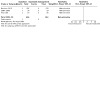
Comparison 1: Induction versus expectant management, Outcome 10: Perinatal mortality
Characteristics of studies
Characteristics of included studies [ordered by study ID]
Boulvain 2015.
| Study characteristics | ||
| Methods | Multi‐centre randomised controlled trial in collaboration with 19 teaching hospitals, members of GROG group, in France, Switzerland and Belguim. Recruitment 2002‐2009. | |
| Participants | 822 women randomised. Women with singleton fetus with cephalic presentation and no contraindications to vaginal delivery. Women were screened between 36‐38 weeks' gestation and those with a fetus with an estimated weight above the 95th percentile at 37 to 38 weeks of gestation, confirmed clinically and then by sonography were included. Exclusion criteria: any contraindication to induction of labour or vaginal delivery or a history of caesarean section, neonatal trauma or shoulder dystocia, severe urinary or faecal incontinence, or insulin treated diabetes. |
|
| Interventions | Intervention: 409 women allocated to induction of labour. Labour was induced between 37+0 and 38+6 weeks and within 3 days or randomisation. The method of induction was at the discretion of the attending physician and according to local protocol. Women with unfavourable cervix had cervical ripening with misoprostol or PGE2 followed by oxytocin infusion if labour had not started. Comparison group: 413 women allocated to expectant management. Women were managed expectantly until labour started spontaneously or the woman required induction (depending on local policy), for example, if PROM occurred or the pregnancy continued beyond 41 weeks. |
|
| Outcomes | The primary outcome was a composite outcome: significant shoulder dystocia, fracture of the clavicle or long bone, brachial plexus injury, intracranial haemorrhage or death. Significant shoulder dystocia was defined as difficulty with delivering the shoulders that was not resolved by the McRoberts’ manoeuvre (flexion of the maternal thighs usually combined with suprapubic pressure) or requiring other manoeuvres (Woods, Rubin or Jaquemier) to rotate the fetus to displace the fetal shoulder impacted behind the maternal pubic bone. The definition also included a delay of 60s or more between delivery of the head and the body. Secondary outcomes: mode of delivery, PPH (1000 mL or more), maternal blood transfusion, and anal sphincter tear, cord blood pH < 7.10, Apgar score < 7 at 5 minutes, admission to NICU, hyperbilirubinaemia (max value > 350 mmol/L). |
|
| Notes | 2 of the authors of this review (MB and OI) were investigators on this trial; these author were not involved in data extraction or in assessing risk of bias for this study. Independent data extraction was carried out by other members of the review team. | |
| Risk of bias | ||
| Bias | Authors' judgement | Support for judgement |
| Random sequence generation (selection bias) | Low risk | Randomisation by centralised computer with permuted blocks (block size 4‐8) with stratification by centre. |
| Allocation concealment (selection bias) | Low risk | Central randomisation. Clinicians and participants had no access to the randomisation and women were randomised after consent had been obtained. |
| Blinding of participants and personnel (performance bias) All outcomes | High risk | It was not feasible to blind women or clinical staff to treatment allocation and lack of blinding may have affected clinical management and outcomes. |
| Blinding of outcome assessment (detection bias) All outcomes | Unclear risk | It was stated that the assessment of the primary outcome was by investigators masked to group allocation. |
| Incomplete outcome data (attrition bias) All outcomes | Low risk | There was very little attrition bias (822 women randomised 818 included in the analysis, 2 women in each group were lost to follow‐up). |
| Selective reporting (reporting bias) | Unclear risk | The trial recruited between 2002 and 2009. It was first registered in 2005 which was at the point recruitment expanded from 1 to 2 countries and from 4 to 19 hospitals, so fairly early in the overall recruitment numbers. There is also a trial protocol available in French. Both registry and protocol planned sample size was 1000. Instead recruitment ended due to financial constraints in Jan 2009 before any analyses were conducted. The published primary outcome “a composite of significant shoulder dystocia, fracture of the clavicle or a long bone, brachial plexus injury, intracranial haemorrhage, or death” includes two components “significant shoulder dystocia” and a delay of > 60 seconds between delivery of the head and body, was not mentioned in the registry but was set out in the protocol. For secondary outcomes, reduction of maternal morbidity and caesarean were mentioned in the registry and other secondary outcomes were pre‐specified in the protocol. The fetal secondary outcomes, CPAP, phototherapy and hypoglycaemia and the maternal secondaries, sepsis, fever (> 38.5 C) and retained placenta were not pre‐specified in either the registry or the protocol. |
| Other bias | Unclear risk | Baseline characteristics were similar between groups (although maternal weight gain appeared greater in the expectant management group (15.6 kg versus 14.7 kg). |
Gonen 1997.
| Study characteristics | ||
| Methods | Randomised controlled trial carried out in Israel. | |
| Participants | 273 women with clinical or previous ultrasound suspicion of macrosomia, or with past history of macrosomia, underwent an ultrasound examination. Women were eligible if ultrasound estimated fetal weight, performed at 38 completed weeks or more, was between 4000 g and 4500 g. Women with diabetes, non‐cephalic presentation, previous caesarean section, or indication for labour induction other than macrosomia were excluded. 6 women in the induction of labour group and 3 in the expectant management group refused to participate after randomisation. 2 women in the expectant management group were lost to follow‐up. | |
| Interventions | Immediate induction of labour using either oxytocin or prostaglandins according to cervical status. Women in the expectant management group: labour was induced at 42 completed weeks of gestation unless fetal distress was suspected. | |
| Outcomes | Caesarean section, instrumental delivery, and spontaneous delivery. Mean birthweight, mean arterial cord blood pH, shoulder dystocia, cephalohematoma, clavicular fracture, brachial plexus palsy, intraventricular haemorrhage. Some results are given stratified according to parity. | |
| Notes | Additional information kindly provided by the authors. | |
| Risk of bias | ||
| Bias | Authors' judgement | Support for judgement |
| Random sequence generation (selection bias) | Low risk | Table of random numbers generated by computer. |
| Allocation concealment (selection bias) | Unclear risk | Not reported. |
| Blinding of participants and personnel (performance bias) All outcomes | High risk | It was not feasible to blind women or clinical staff to treatment allocation and lack of blinding may have affected clinical management and outcomes. |
| Blinding of outcome assessment (detection bias) All outcomes | High risk | Not reported, likely that outcome assessment was not blinded. |
| Incomplete outcome data (attrition bias) All outcomes | Low risk | All losses accounted for: 6 refused to participate in induction group and 3 in expectant group; 2 lost to follow‐up from expectant group; this left 273 women available for analysis: 134 in induction group and 139 in the expectant group. |
| Selective reporting (reporting bias) | Low risk | All expected outcome results reported. |
| Other bias | Low risk | Baseline characteristics similar between groups. No other bias apparent. |
LIBBY 1998.
| Study characteristics | ||
| Methods | Randomised controlled trial carried out in two centres in the UK. | |
| Participants | 59 women (30 induction; 29 await spontaneous labour) with a fetus estimated above the 97th percentile (abdominal circumference, estimated fetal weight according to Chitty 1994). | |
| Interventions | Immediate induction of labour using either oxytocin or prostaglandins. Women in the expectant management group: labour was induced at 42 completed weeks of gestation. | |
| Outcomes | Mode of delivery, birthweight, delay and adverse maternal or neonatal outcome. | |
| Notes | No adverse fetal or maternal outcome. Standard deviation estimated from the information available (interquartile ranges). | |
| Risk of bias | ||
| Bias | Authors' judgement | Support for judgement |
| Random sequence generation (selection bias) | Low risk | Table of random numbers generated by computer. |
| Allocation concealment (selection bias) | Low risk | Sealed opaque, consecutively‐numbered envelopes. |
| Blinding of participants and personnel (performance bias) All outcomes | High risk | It was not feasible to blind women or clinical staff to treatment allocation and lack of blinding may have affected clinical management and outcomes. |
| Blinding of outcome assessment (detection bias) All outcomes | High risk | Not reported; it is likely that outcome assessment was not blinded. |
| Incomplete outcome data (attrition bias) All outcomes | Low risk | 29/30 women in the induction group had induction, compared to 14/29 in the expectant management group; analysis was however performed on an intention‐to‐treat basis. |
| Selective reporting (reporting bias) | Unclear risk | Not possible to tell ‐ unpublished data. |
| Other bias | Unclear risk | Unclear. |
Tey 1995.
| Study characteristics | ||
| Methods | Randomised controlled trial carried out in the USA. | |
| Participants | 40 women at 37 to 42 weeks, with an ultrasound estimated fetal weight between 4000 g and 4750 g. | |
| Interventions | Induction of labour was performed with PGE2 gel if the cervical status was unfavourable (Bishop score < 6), followed by oxytocin infusion. | |
| Outcomes | Mean birthweight, caesarean section and shoulder dystocia. | |
| Notes | Additional information kindly provided by the authors. | |
| Risk of bias | ||
| Bias | Authors' judgement | Support for judgement |
| Random sequence generation (selection bias) | Low risk | Computer‐generated table of random numbers. |
| Allocation concealment (selection bias) | Low risk | Sealed opaque, consecutively‐numbered envelopes, prepared by an individual not involved in the study. Envelopes were opened only after inclusion of women. |
| Blinding of participants and personnel (performance bias) All outcomes | High risk | It was not feasible to blind women or clinical staff to treatment allocation and lack of blinding may have affected clinical management and outcomes. |
| Blinding of outcome assessment (detection bias) All outcomes | High risk | Not reported; it was likely that outcome assessment was not blinded. |
| Incomplete outcome data (attrition bias) All outcomes | Unclear risk | Not clear ‐ only published as an abstract. |
| Selective reporting (reporting bias) | Unclear risk | Not clear ‐ only published as an abstract. |
| Other bias | Unclear risk | Not clear ‐ only published as an abstract. |
CPAP: continuous positive airways pressure NICU: neonatal intensive care unit PGE2: prostaglandins E2 PPH: postpartum haemorrhage PROM: premature rupture of membranes
Characteristics of ongoing studies [ordered by study ID]
Perlitz 2014.
| Study name | Induction of labour versus expectant management of large for gestational age/macrosomic babies at term. A multi‐center trial (IOLEMMT) |
| Methods | Randomised controlled trial. |
| Participants | Women 18‐45 years age with large for gestational age or suspected macrosomic babies 38 to 40 + 3 weeks' gestation with singleton pregnancy, cephalic presentation with estimated fetal weight 3800 to 4500 g. Women with diabetes, major fetal malformation or previous caesarean birth excluded. Proposed sample: 474 women. |
| Interventions | Induction of labour versus expectant management (up to 40 weeks + 6 days). |
| Outcomes | Shoulder dystocia, brachial plexus injuries, fracture, intraventricular haemorrhage, cephalhematoma, caesarean section. |
| Starting date | January 2015. |
| Contact information | Dr Yuri Perlitz yperlitz@poria.health.gov.II |
| Notes | Estimated completion 2019. |
Differences between protocol and review
The methods have been updated in accordance with the current standard methods for Cochrane Pregnancy and Childbirth Group.
Methods/outcomes ‐ we have separated our outcomes into primary and secondary outcomes. We have also revised our list of outcomes. In the earlier version of this review the list of outcomes was as follows.
Maternal outcomes ‐ proportion of women having caesarean section; instrumental delivery and spontaneous delivery.
Perinatal outcomes ‐ shoulder dystocia; brachial plexus injury; clavicular fracture; intracranial haemorrhage, diagnosed by sonography.
For this update, we have specified the following outcomes.
Primary outcomes
Maternal outcomes
Caesarean section
Instrumental delivery
Perinatal outcomes
Shoulder dystocia
Brachial plexus injury
Fracture (any)
Neonatal asphyxia (low arterial cord blood pH, or low five‐minute Apgar score)
Secondary outcomes
Maternal outcomes
Spontaneous delivery
Third‐ and fourth‐degree perineal tears
Maternal dissatisfaction (pain, sexual dysfunction)
Perinatal outcomes
Mean birthweight (g)
Admission to neonatal intensive care unit
Intracranial haemorrhage
Convulsions
Perinatal mortality
Long‐term disability in childhood
We have also reported findings for the following non pre‐specified outcomes.
Significant shoulder dystocia (trialist defined)
Serious neonatal morbidity or death (composite outcome)
Use of phototherapy
Cephalohematoma
Contributions of authors
Olivier Irion and Michel Boulvain wrote the protocol, collected the data and contributed to writing this updated review. Jim Thornton collected the data and contributed to writing this update. Therese Dowswell collected the data and contributed to writing this update.
Sources of support
Internal sources
University of Geneva, Switzerland
External sources
-
National Institute for Health Research (NIHR), UK
NIHR Cochrane Programme Grant Project: 13/89/05 – Pregnancy and childbirth systematic reviews to support clinical guidelines
Declarations of interest
Two of authors (MB and OI) are on one of the included trials (Boulvain 2015) and a third (JT) on another (LIBBY 1998). They were not involved in carrying out data extraction or assessing risk of bias for their own trials. Data extraction and assessment of risk of bias was for these trials was carried out by Leanne Jones and Therese Dowswell, Research Associates in the Cochrane Pregnancy and Childbirth Group.
Michel Boulvain was an invited speaker at a DIP congress on gestational diabetes and received accommodation expenses.
Therese Dowswell is employed by the University of Liverpool on an NIHR Cochrane Programme Grant (13/89/05) to work on a range of Cochrane Reviews. In the past 3 years her institution has received a grant from WHO to support her working on other Cochrane reviews. The Funders have no influence on the content or conclusions of the relevant Cochrane reviews.
Olivier Irion receives salary support from the University Hospitals of Geneva and the University of Geneva. He has received money to provide expert (extra‐) judiciary reports unrelated to this review. He has also been refunded for travel and meetings fees by his institution and the Swiss Ob‐Gyn society and received payment from the University of Geneva for teaching (around 6 hours per year) on courses provided to the Geneva Midwives school.
Edited (no change to conclusions)
References
References to studies included in this review
Boulvain 2015 {published and unpublished data}
- Boulvain M, Senat MV, Perrotin F, Winer N, Beucher G, Subtil D, et al. Induction of labour versus expectant management for large-for-date fetuses: a randomised controlled trial. Lancet 2015;385(9987):2600-5. [DOI] [PubMed] [Google Scholar]
- Boulvain M, Senat MV, Rozenberg P, Irion O. Induction of labor or expectant management for large-for-dates fetuses: a randomized controlled trial. American Journal of Obstetrics and Gynecology 2012;206(Suppl 1):S2. [Google Scholar]
- Boulvain M. Induce or wait for estimated macrosomia (DAME). Personal communication 2002.
- Rozenberg P. DAME: induction of labor or waiting for suspicion fetal macrosomia. ClinicalTrials.gov (http://clinicaltrials.gov/) [21 March 2006] 2006.
Gonen 1997 {published and unpublished data}
- Gonen O, Rosen DJD, Dolfin Z, Kaneti HY, Katzenstein M, Regev R, et al. Induction of labor versus expectant management in macrosomia: a prospective randomized study. In: Proceedings of 14th European Congress of Perinatal Medicine; 1994 June 5-8; Helsinki, Finland. 1994:374.
- Gonen O, Rosen DJD, Dolfin Z, Tepper R, Markov S, Fejgin MD. Induction of labor versus expectant management in macrosomia: a randomized study. Obstetrics & Gynecology 1997;89:913-7. [DOI] [PubMed] [Google Scholar]
LIBBY 1998 {unpublished data only}ISRCTN98146741
- Kean LH. Leave alone or induce for the big baby (LIBBY). National Research Register. www.update-software.com/NRR (accessed 10 September 2000).
- Thornton J. Unpublished data of the LIBBY pilot (as supplied October 2006). Data on file.
Tey 1995 {published and unpublished data}
- Tey A, Eriksen NL, Blanco JD. A prospective randomized trial of induction versus expectant management in nondiabetic pregnancies with fetal macrosomia [abstract]. American Journal of Obstetrics and Gynecology 1995;172:293. [Google Scholar]
References to ongoing studies
Perlitz 2014 {published data only}
- Perlitz Y. Induction of labor versus expectant management of large for gestational age/macrosomic babies at term. a multi-center randomized trial. ClinicalTrials.gov (http://clinicaltrials.gov/) [accessed 25 February 2016] 2014.
Additional references
Berard 1998
- Berard J, Dufour P, Vinatier D, Subtil D, Vanderstichele S, Monnier JC, et al. Fetal macrosomia: risk factors and outcome. A study of the outcome concerning 100 cases >4500 g. European Journal of Obstetrics, Gynecology, & Reproductive Biology 1998;77(1):51-9. [DOI] [PubMed] [Google Scholar]
Cameron 2014
- Cameron CM, Shibl R, McClure RJ, Ng SK, Hills AP. Maternal pregravid body mass index and child hospital admissions in the first 5 years of life: results from an Australian birth cohort. International Journal of Obesity 2014;38(10):1268-74. [DOI] [PubMed] [Google Scholar]
Chatfield 2001
- Chatfield J. ACOG issues guidelines on fetal macrosomia. American College of Obstetricians and Gynecologists. American Family Physician 2001;64(1):169-70. [PubMed] [Google Scholar]
Chitty 1994
- Chitty LS Altmann DG Henderson A Campbell S. Charts of fetal size: 3. Abdominal measurements. BJOG: an international journal of obstetrics and gynaecology 1994;101:125-131. [DOI: 10.1111/j.1471-0528.1994.tb13077.x] [DOI] [PubMed] [Google Scholar]
Coomarasamy 2005
- Coomarasamy A, Connock M, Thornton JG, Khan KS. Accuracy of ultrasound biometry in the prediction of macrosomia: a systematic quantitative review. BJOG: an international journal of obstetrics and gynaecology 2005;112(11):1461-6. [DOI] [PubMed] [Google Scholar]
Delpapa 1991
- Delpapa EH, Muller-Heubach E. Pregnancy outcome following ultrasound diagnosis of macrosomia. Obstetrics & Gynecology 1991;78:340-3. [PubMed] [Google Scholar]
Friesen 1995
- Friesen CD, Miller AN, Rayburn WF. Influence of spontaneous or induced labor on delivering the macrosomic fetus. American Journal of Perinatology 1995;12:63-6. [DOI] [PubMed] [Google Scholar]
Gaudet 2014
- Gaudet L, Wen SW, Walker M. The combined effect of maternal obesity and fetal macrosomia on pregnancy outcomes. Journal of Obstetrics & Gynaecology Canada: JOGC 2014;36(9):776-84. [DOI] [PubMed] [Google Scholar]
Higgins 2011
- Higgins JPT, Green S, editors. Cochrane Handbook for Systematic Reviews of Interventions Version 5.1.0 [updated March 2011]. The Cochrane Collaboration, 2011. Available from www.cochrane-handbook.org.
Johnstone 1997
- Johnstone FD. Prediction of macrosomia in diabetic pregnancy. Contemporary Reviews in Obstetrics and Gynaecology 1997;2:113-20. [Google Scholar]
Ju 2009
- Ju H, Chadha Y, Donovan T, O'Rourke P. Fetal macrosomia and pregnancy outcomes. Australian & New Zealand Journal of Obstetrics & Gynaecology 2009;49(5):504-9. [DOI] [PubMed] [Google Scholar]
Malin 2016
- Malin GL, Bugg GJ, Takwoingi Y, Thornton JG, Jones NW. Antenatal magnetic resonance imaging versus ultrasound for predicting neonatal macrosomia: a systematic review and meta-analysis. BJOG: an international journal of obstetrics and gynaecology 2016;123(1):77-88. [DOI] [PubMed] [Google Scholar]
Mishanina 2014
- Mishanina E, Rogozinska E, Thatthi T, Uddin-Khan R, Khan KS, Meads C. Use of labour induction and risk of cesarean delivery: a systematic review and meta-analysis. Canadian Medical Association Journal 2014;186(9):665-73. [DOI] [PMC free article] [PubMed] [Google Scholar]
Mohammadbeigi 2013
- Mohammadbeigi A, Farhadifar F, Soufi Zadeh N, Mohammadsalehi N, Rezaiee M, Aghaei M. Fetal macrosomia: risk factors, maternal, and perinatal outcome. Annals of Medical Health Science Research 2013;3(4):546-50. [DOI] [PMC free article] [PubMed] [Google Scholar]
Perlow 1996
- Perlow JH, Wigton T, Hart J, Strassner HT, Nageotte MP, Wolk BM. Birth trauma: a five-year review of incidence and associated perinatal factors. Journal of Reproductive Medicine 1996;41:754-60. [PubMed] [Google Scholar]
RevMan 2014 [Computer program]
- The Nordic Cochrane Centre, The Cochrane Collaboration Review Manager (RevMan). Version 5.3. Copenhagen: The Nordic Cochrane Centre, The Cochrane Collaboration, 2014.
Saccone 2015
- Saccone G, Berghella V. Induction of labor at full term in uncomplicated singleton gestations: a systematic review and metaanalysis of randomized controlled trials. American Journal of Obstetrics and Gynecology 2015;213(5):629-36. [DOI] [PubMed] [Google Scholar]
Sanchez‐Ramos 2002
- Sanchez-Ramos L, Bernstein S, Kaunitz AM. Expectant management versus labor induction for suspected fetal macrosomia: a systematic review. Obstetrics and Gynecology 2002;100(5 Pt 1):997-1002. [PMID: ] [PubMed] [Google Scholar]
Thiery 1989
- Thiery M, Baines CJ, Keirse MJNC. The development of methods for inducing labour. In: Chalmers I, Enkin MW, Keirse MJNC, editors(s). Effective Care in Pregnancy and Childbirth. Oxford: Oxford University Press, 1989:969. [Google Scholar]
Weeks 1995
- Weeks JW, Pitman T, Spinnato JA. Fetal macrosomia: does antenatal prediction affect delivery route and birth outcomes? American Journal of Obstetrics and Gynecology 1995;173:1215-9. [DOI] [PubMed] [Google Scholar]
Wood 2014
- Wood S, Cooper S, Ross S. Does induction of labour increase the risk of caesarean section? A systematic review and meta-analysis of trials in women with intact membranes. BJOG: an international journal of obstetrics and gynaecology 2014;121(6):674-85. [DOI] [PubMed] [Google Scholar]
References to other published versions of this review
Irion 1998
- Irion O, Boulvain M. Induction of labour for suspected fetal macrosomia. Cochrane Database of Systematic Reviews 1998, Issue 2. Art. No: CD000938. [DOI: 10.1002/14651858.CD000938] [DOI] [PubMed] [Google Scholar]


